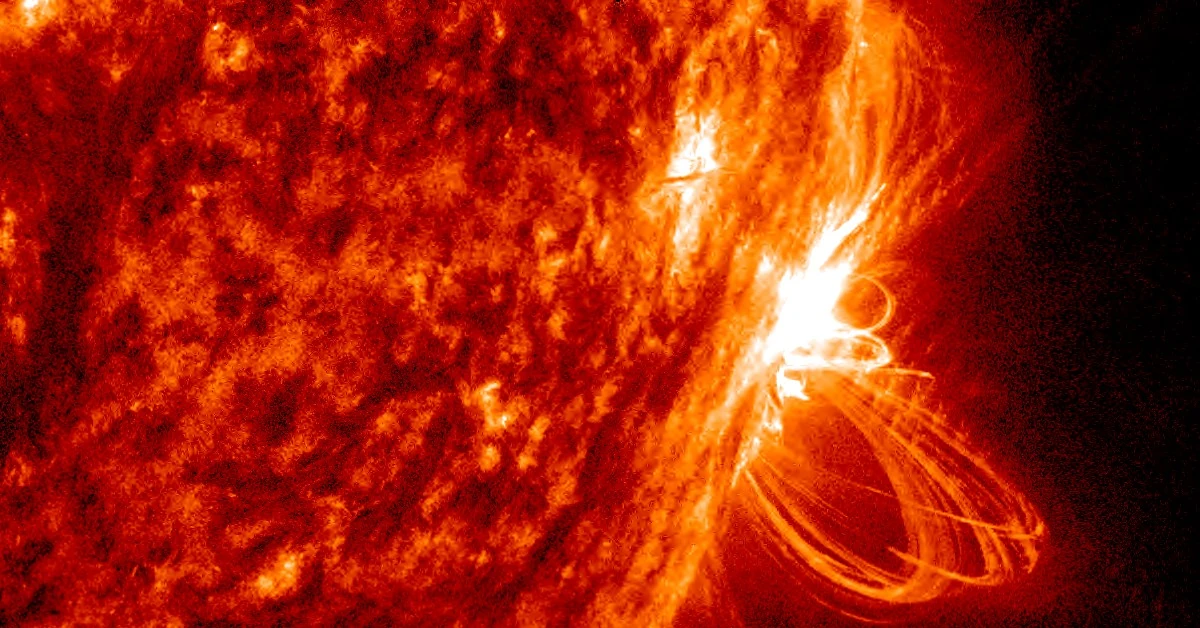Major X8.7 flare erupts from Region 3664 — the strongest solar flare of Solar Cycle 25

A powerful solar flare measuring X8.7 erupted from Active Region 3664 — currently located off the west limb of the Sun — at 16:51 UTC on May 14, 2024. The event started at 16:46 and ended at 17:02 UTC.
- This is the strongest solar flare of Solar Cycle 25 and the 16th X-class flare since May 1.
- Today’s X8.7 is also the strongest flare since X9.3 on September 10, 2017 — the strongest solar flare of Solar Cycle 24.
A Type II (estimated velocity of 497 km/s) and IV radio emissions were associated with the event — indicating a strong coronal mass ejection (CME) was produced.
In addition, a 10cm Radio Burst (tenflare), lasting 7 minutes and with a peak flux of 1 100 sfu was associated with this event. A 10cm radio burst indicates that the electromagnetic burst associated with a solar flare at the 10cm wavelength was double or greater than the initial 10cm radio background. This can be indicative of significant radio noise in association with a solar flare. The noise is generally short-lived but can cause interference for sensitive receivers including radar, GPS, and satellite communications.
Radio emissions were forecast to be most degraded over the Americas, East Pacific, and Northern Atlantic at the time of the flare.
This one deserves a close up!
— NASA Sun & Space (@NASASun) May 14, 2024
Here’s another, multi-wavelength look at today’s X8.7-class solar flare, the most powerful of this solar cycle. pic.twitter.com/TxxGDNTXmF



Coronagraph imagery of the CME was not available at the time of press. However, the location of this region does not favor Earth-directed CMEs anymore.
The opposite is true for solar radiation storms. In fact, periods of S1 – Minor and S2 – Moderate solar radiation storms were registered since 13:50 UTC on May 13 and there is a good chance radiation storm will continue over the next 24+ hours.

Interestingly, just over 40 minutes after today’s X8.7 flare — at 17:48 UTC, an M4.4 flare erupted from a new region emerging on the SE limb — AR 3682.
A large CME was associated with this event but the location of the region still doesn’t favor Earth-directed CMEs. However, this can be an early signal of continued increased solar activity over the next week or so.
The Sun has produced more than 100 M-class and 16 X-class flares since May 1, and a series of Earth-directed CMEs — some of which merged into one powerful Cannibal CME and produced historic G5 – Extreme geomagnetic storm on May 10 and 11.
The last time Earth experienced a G5 – Extreme geomagnetic storm was in October 2003 — dubbed the Halloween Storms of 2003. These storms resulted in power outages in Sweden and damaged transformers in South Africa. Surprisingly, they occurred 2 to 3 years after solar maximum.
This time, NOAA reported some minor power grid irregularities and impacts on high-frequency communications and GPS, while Elon Musk reported his Starlink satellites are ‘under a lot of pressure but holding up so far.’


3667 – Alpha
3670 – Beta-Gamma
3671 – Beta
3672 – Beta
3673 – Alpha
3674 – Beta
3675 – Beta-Gamma
3676 – Beta-Gamma-Delta
3678 – Alpha
3679 – Beta-Gamma
3680 – Beta
3681 – Alpha
G1 – Minor to G2 – Moderate geomagnetic storming is likely on March 14 due to weak positive polarity coronal hole high speed stream (CH HSS) coupled with CME produced on May 12.

Featured image credit: X8.7 solar flare on May 14, 2024. Credit: NASA SDO/AIA 304, Helioviewer, The Watchers

Good morning to you Teo, I just noticed, very nice photo of you. You’re as handsome as can be. What do you think about all these crazy sunspots and solar flares? In your expert opinion, do you think another major 1859-like Carrington Event will happen soon in the near future?
Thank you for your kind words. Regarding the sunspots and solar flares, solar activity is indeed increasing as we approach the peak of the current solar cycle, so we can’t rule out a similar event. It’s true that we are not prepared for such an event. Luckily, such things are always accompanied by great visuals so not everything is bad.
Thank you Teo for your reply. Yes, those Auroras are so magnificently beautiful, or at least the ones I’ve seen in videos. I live on the east coast U.S. [Virginia Beach, VA) and we were supposed to see them even as far out as here on the night of May 10th, but the skies are were too cloudy and overcast to see anything at all that night – such is always my luck. Maybe one day I’ll be so lucky.
The Sun is super-active and ultra-intense solar flares will be produced during the peak of this solar maximum. However, according to my understanding the reason is mainly because of the impact of its twin (the dark star) which is getting nearer to the Sun and approaching the inner part of the solar system. I believe in the very near future, it will start reflecting the light of the Sun and become visible to space and land based telescopes
The current solar maximum will produce the strongest solar flare. In other words, the strongest solar flare since the activity of solar cycles started to be recorded will be produced during the peak of this solar
maximum. However, there are reasons why that will be the case. Namely, because of the dark star which is approaching the inner part of the solar and inducing huge magnetic pressure on the sun